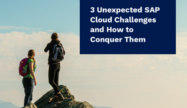SAP Cloud Migration
Filter By
Browse By
- SAP Analytics and AI
- SAP Application Development and Integration
- All SAP Application Development and Integration
- SAP ABAP
- SAP ABAP Development Tools
- SAP ABAP Test Cockpit
- SAP API Management
- SAP BAPI
- SAP Basis
- SAP BRF
- SAP Business Application Studio
- SAP CMS
- SAP Design Studio
- SAP Development Tools
- SAP DevOps
- SAP EAI
- SAP EDI
- SAP Extension Suite
- SAP Fiori
- SAP Fiori Elements
- SAP Integration Suite
- SAP Low Code Application Development
- SAP Low Code Automation
- SAP Netweaver
- SAP Release Management
- SAP UI5
- SAP Web Application Server
- SAP Web IDE
- SAP Business Process Management
- SAP Center of Excellence
- SAP CIO
- SAP Customer Experience
- SAP Data and Data Management
- All SAP Data and Data Management
- SAP BW
- SAP BW/4HANA
- SAP Crystal Reporting
- SAP Data Archiving
- SAP Data Center
- SAP Data Governance
- SAP Data Integration
- SAP Data Migration
- SAP Data Quality
- SAP Data Services
- SAP Data Strategy
- SAP Data Visualization
- SAP Data Warehouse Cloud
- SAP DMS
- SAP Document Control
- SAP EIM
- SAP ETL
- SAP ETL Tools
- SAP HANA
- SAP HANA Administration
- SAP HANA Deployment Infrastructure
- SAP HANA Studio
- SAP Master Data
- SAP Master Data Governance
- SAP MDM
- SAP Enterprise Architect
- SAP Enterprise Asset Management
- SAP ERP
- SAP Finance
- All SAP Finance
- SAP Accounting
- SAP AR AP
- SAP Asset Accounting
- SAP Billing Systems
- SAP BPC
- SAP BRIM
- SAP Cash Management
- SAP Central Finance
- SAP Controlling
- SAP COPA
- SAP Cost Center Accounting
- SAP e-invoicing
- SAP FICO
- SAP Finance Automation
- SAP Financial Closing Cockpit
- SAP Financial Consolidation
- SAP Financial Planning
- SAP FX Risk
- SAP General Ledger
- SAP Global Tax Management
- SAP Hyperion
- SAP Order to Cash
- SAP Payment Processing
- SAP Profitability Analysis
- SAP Rebate Management
- SAP S/4HANA Finance
- SAP Universal Journal
- SAP Governance Risk and Compliance
- SAP Human Capital Management
- SAP Intelligent Technologies
- SAP Platform and Technology
- All SAP Platform and Technology
- SAP Business Technology Platform
- SAP Cloud Connector
- SAP Cloud Integration Platform
- SAP Cloud Migration
- SAP Cloud Platform
- SAP Cloud Providers
- SAP Cloud Strategy
- SAP Container Platform
- SAP Digital Asset Management
- SAP Digital Integration Hub
- SAP Digital Signature
- SAP HANA Enterprise Cloud
- SAP HEC
- SAP Hyperscalers
- SAP Infrastructure
- SAP Messaging
- SAP Smart Forms
- SAP Quality and Testing
- SAP Security
- SAP Spend Management
- SAP Supply Chain Management
- All SAP Supply Chain Management
- SAP APO
- SAP Asset Management
- SAP Business Network
- SAP Digital Manufacturing Cloud
- SAP Digital Twin
- SAP EWM
- SAP IBP
- SAP Inventory Management
- SAP Label Printing
- SAP Logistics
- SAP Manufacturing
- SAP Manufacturing Automation
- SAP MES
- SAP MII
- SAP MM
- SAP MRO
- SAP MRP
- SAP Order Management
- SAP Plant Maintenance
- SAP PLM
- SAP Production Planning
- SAP S&OP
- SAP SD
- SAP SPM
- SAP Supply Chain Planning
- SAP Track and Trace
- SAP Transportation Management
- SAP System Administration
What is SAP Cloud Migration?
Moving to the cloud has become increasingly critical for SAPinsiders today as they look to replace existing hardware and infrastructure that no longer delivers the required performance. Initial moves to the cloud were largely focused on putting in place infrastructure that provided more flexibility and scalability while being able to deploy systems more quickly. Today’s SAP Cloud Migration involves integrating SAP and non-SAP systems, architecture redesign, hybrid cloud environments, and multiple cloud providers. Today’s cloud migration focus is also on increasing security while managing cost. These two requirements were the most important in 2021 research conducted by SAPinsider on moving SAP workloads to the cloud and continue to be crucial for organizations planning for long-term cloud success.
What is SAP Cloud Migration?
Moving to the cloud has become increasingly critical for SAPinsiders today as they look to replace existing hardware and infrastructure that no longer delivers the required performance. Initial moves to the cloud were largely focused on putting in place infrastructure that provided more flexibility and scalability while being able to deploy systems more quickly. Today’s SAP Cloud Migration involves integrating SAP and non-SAP systems, architecture redesign, hybrid cloud environments, and multiple cloud providers. Today’s cloud migration focus is also on increasing security while managing cost. These two requirements were the most important in 2021 research conducted by SAPinsider on moving SAP workloads to the cloud and continue to be crucial for organizations planning for long-term cloud success.
Key Considerations for SAPinsiders:
- Spend time understanding whether your SAP Cloud Migration concerns are valid. Many organizations have concerns about challenges with moving to the cloud. These include topics such as cost, security, availability, performance, and the complexity of integration. But some of the concerns may be misconceptions. Taking the time to educate teams on topics around cloud migration is an important part of the process. Just as important is understanding what your concerns are and determining how valid those concerns may be. This article by Axel Streichardt discusses some of these challenges and how SAP customers can address them to ensure cloud success.
- SAP workloads are increasingly moving to cloud environments. In research that SAPinsider conducted in the second half of 2021, 88% of respondents indicated that they are running at least some SAP workloads in the cloud. More workloads are being moved to the cloud over the next two years, particularly solutions like procurement, customer relationship management, analytics, travel and expense, and finance. The biggest factors that are part of those decisions to move are greater flexibility, the deployment mode, increased scalability, and distributed data scenarios.
- Understand what type of cloud you need to meet your organization’s requirements and what will best support them in the future. An SAP Cloud Migration can involve private cloud, public cloud, managed service providers, or some sort of hybrid landscape. Some may offer the best benefits today, while others may be needed if planning for the future. Spending the time to look at what your organization needs today and what is important for the future is a critical step in any cloud migration. This may also involve learning from what other organizations have done and why those choices were the right ones for them. In this article multiple executives were asked about their cloud choices, why they worked then, and what they have planned for the future.
80 results
-

3 Unexpected SAP Cloud Challenges and How to Conquer Them
Reading time: 1 min
Cloud computing is the use of computer system resources and services located over the internet and not locally. From local bakers to multinational banks, many businesses are rapidly moving and operating some, and even a majority, of their critical corporate infrastructure and systems into the cloud. Some substantial benefits of cloud migration include significantly lowering…
-

eBook: A smarter cloud for your SAP
Reading time: 1 min
In 2017, plastics innovation and manufacturing company Spartech faced a six-month window to carve out SAP ECC, BW, and non-SAP systems from its parent company after a divestiture. With 15 plants operating 24/7, Spartech needed zero downtime while migrating over two terabytes of SAP and non-SAP data, required a strategically re-architected environment for maximum performance…
-

Green manufacturer Ingevity offloads data center and undergoes digital transformation
Reading time: 1 min
Global manufacturing firm Ingevity inherited outdated systems from its former parent company. As they neared the end of a five-year agreement for their on-premises data center, the team began planning a complex migration to Microsoft Azure. Working with Microsoft Preferred Partner Protera for consolidation and management, Ingevity moved 450 SAP and non-SAP servers and 74…
-
-

- SAP Cloud Migration
 Premium
Premium
Why migrate to SAP Cloud Platform Integration?
Reading time: 4 mins
The deadline for ending mainstream maintenance SAP Process Orchestration to 2027 and 2030 means that businesses need to migrate to SAP Cloud Platform Integration. SAP Cloud Platform Integration Suite, a modular integration platform-as-a-service enables seamless integration across applications and systems, whether they are SAP, non-SAP, on-premise, cloud, or hyperscale. In this article, learn about the migration…
-

- SAP Cloud Migration
 Premium
Premium
Proactively Monitor SAP Systems in the Cloud
Reading time: 11 mins
Many are embarking on SAP cloud migrations or upgrade projects. While this move to the cloud reaps many benefits such as cost-savings, flexibility, reliability, high availability and data access improvements, it also enables more diverse and flexible landscapes than ever. Jointly created by SoftwareONE and Splunk, SAP gives customers a platform that can correlate SAP…
-

A Robust Approach for Modernizing SAP with Microsoft Azure
Reading time: 6 mins
Deploying SAP on the cloud is a major, risky, and expensive project for any organization that is embarking on the move. Skills and deep experience are critical to deciding on the deployment approaches and infrastructure choices, preparing existing systems and data, assigning a strong team of internal IT and business resources supplemented by partners, and…
-

Video: A Robust Approach for Modernizing SAP with Microsoft Azure
Companies chose to deploy of SAP Azure for various reasons ranging from the very strategic to the technical evolution. Khoj Information Technology has processes and tools to achieve value and reduce risk.
-
-

Future-Proof Your SAP S/4HANA Cloud Migration
September 20, 2022
According to the latest SAPinsider research, the number of organizations leveraging the cloud as part of their SAP S/4HANA deployment is on the rise. And with most respondents (87%) indicating performance as a top requirement for their SAP S/4HANA initiative, it is imperative to implement performance measures as part of your cloud strategy. Join industry…
-

From an SAP S/4HANA PoC on Azure to All-In Migration: A CIO’s Perspective
September 27, 2022
The acquisition of several new entities and added business units posed an opportunity for transmission manufacturer Altra Motion, and enabled CIO Rick Klotz toreview his options for scaling with public cloud, as well as the potential impact of transforming to SAP S/4HANA across the organization. In this 30-minute webcast, hear from CIO Rick Klotz on…
-

The Innovation Imperative: The Business Value of SAP Cloud Migrations
January 07, 2022
SAP systems have long been core to the business success of organizations around the globe. Today, leading companies are using their SAP environments, not just as critical systems of record, but as platforms to create more agile, innovation-fueled approaches to business management. To unlock this innovation and secure a competitive advantage, enterprises are modernizing applications…
Featured Insiders
-

Edward Yee
Director of SAP on Azure Business, Microsoft Canada
-

Suraj Gauli
PWC
-

Indrajit Roy Chowdhury
Vice President, Nielsen Media Research
Become a Member
Unlimited access to thousands of resources for SAP-specific expertise that can only be found here.
Upcoming Events
Related Vendors
Your request has been successfully sent


